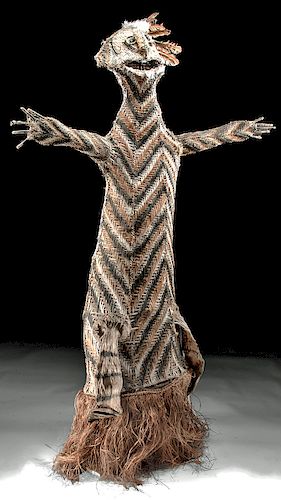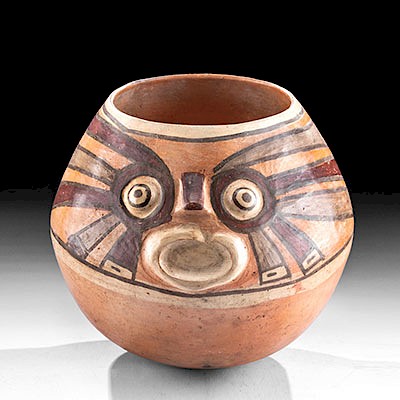Huge Early 20th C. Papua New Guinea Fiber Dance Mask
Lot 139
About Seller
Artemis Fine Arts
686 S Taylor Ave, Ste 106
Louisville, CO 80027
United States
Selling antiquities, ancient and ethnographic art online since 1993, Artemis Gallery specializes in Classical Antiquities (Egyptian, Greek, Roman, Near Eastern), Asian, Pre-Columbian, African / Tribal / Oceanographic art. Our extensive inventory includes pottery, stone, metal, wood, glass and textil...Read more
Categories
Estimate:
$1,000 - $1,500
Absentee vs Live bid
Two ways to bid:
- Leave a max absentee bid and the platform will bid on your behalf up to your maximum bid during the live auction.
- Bid live during the auction and your bids will be submitted real-time to the auctioneer.
Bid Increments
| Price | Bid Increment |
|---|---|
| $0 | $25 |
| $300 | $50 |
| $1,000 | $100 |
| $2,000 | $250 |
| $5,000 | $500 |
| $10,000 | $1,000 |
| $20,000 | $2,500 |
| $50,000 | $5,000 |
| $100,000 | $10,000 |
| $200,000 | $20,000 |
About Auction
By Artemis Fine Arts
Dec 5, 2019
Set Reminder
2019-12-05 10:00:00
2019-12-05 10:00:00
America/New_York
Bidsquare
Bidsquare : Ancient / Ethnographic - Holiday Edition
https://www.bidsquare.com/auctions/artemis-gallery/ancient-ethnographic---holiday-edition-4710
What to give this holiday season? Ancient & Ethnographic Art of course! Our special Holiday auction features hundreds of unique finds from all over the world. Artemis Fine Arts info@artemisgallery.com
What to give this holiday season? Ancient & Ethnographic Art of course! Our special Holiday auction features hundreds of unique finds from all over the world. Artemis Fine Arts info@artemisgallery.com
- Lot Description
Oceania, Papua New Guinea, probably Gulf Province, Tovei Village, ca. early to mid 20th century CE. An enormous yet playful dance mask woven from colorful plant fibers, the body presenting an attractive zigzag pattern, with two hanging bark 'sleeves' extending from openings on the lower body, and a long sago leaf skirt attached below the wooden ring that serves as the base of the figure. The head is somewhat anthropomorphic but definitely abstract, also woven of fiber, with openwork eyes (trimmed in cassowary feathers), an openwork mouth as well as a pronounced nose with extended septum or nose ring. The curved lines adorning the visage that resemble face paint are familiar from smaller Papuan masks. Cassowary feathers also project from the top of the head. Further contributing to the mask's expressive nature are the upraised arms with extended fingers. Masks like this one were made for elaborate ceremonies, often commemorating important agricultural activities in the local community. Size: 25" W x 66" H (63.5 cm x 167.6 cm); 82" H (208.3 cm) on included custom stand making it possible to see the lovely skirt.
Frank Hurley, a famous Australian photographer best known for his work photographing Shackleton's expeditions to Antarctica, also spent time from 1920 to 1923 photographing the indigenous people of New Guinea. One of his photographs shows two people wearing masks similar to this one.
Provenance: private Tucson, Arizona, USA collection, acquired between 1950 and 1985
All items legal to buy/sell under U.S. Statute covering cultural patrimony Code 2600, CHAPTER 14, and are guaranteed to be as described or your money back.
A Certificate of Authenticity will accompany all winning bids.
We ship worldwide and handle all shipping in-house for your convenience.
#150834Light wear on surface commensurate with age. The bark sleeves show age wear but are still attached. The sago leaf skirt has a relatively small area of separation from the lower ring. Otherwise in nice condition with light fading to the pigment on the surface.Condition
- Shipping Info
-
All shipping is handled in-house for your convenience. Your invoice from Artemis Gallery will include shipping calculation instructions. If in doubt, please inquire BEFORE bidding for estimated shipping costs for individual items.
-
- Buyer's Premium



 EUR
EUR CAD
CAD AUD
AUD GBP
GBP MXN
MXN HKD
HKD CNY
CNY MYR
MYR SEK
SEK SGD
SGD CHF
CHF THB
THB














